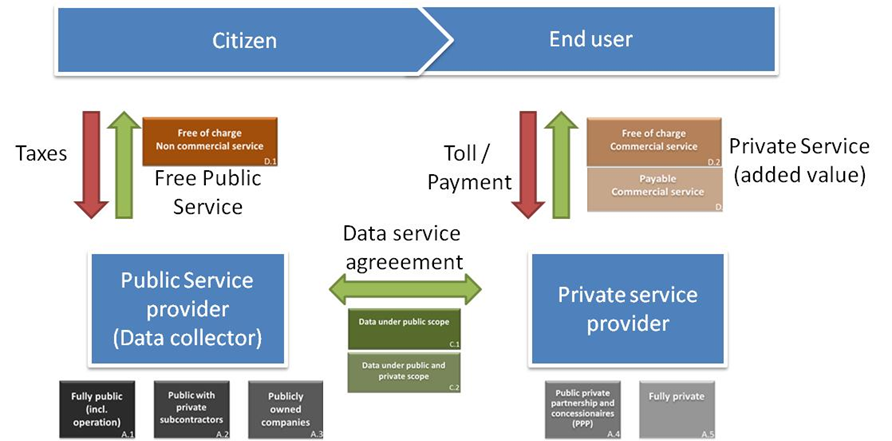Roles and actors
European Traveller Information can be deemed to have five main actors necessary for the entire supply chain of traveller information. These are:
- Content providers;
- Service operators;
- Service providers;
- Communication network operators; and
- End users.
Presently the roles outlined above (with the exception of the end user) are provided by different parties e.g. national and local authorities, either directly or through additional agreements with e.g. road operators, or by private industry when there is a business case for the development of such a service. These roles are normally governed by the following conditions:
- National authorities (or the entitled entity) provide information when:
- There is an obligation on society to provide this information;
- Provision contributes to policy goals;
- There is existing market failure to be addressed.
- Private industry provide information when:
- A successful business model exists.
- Private, non-profit developers:
- Groups such as students or those developing as a hobby, where they see a need.
Due to the diverse nature of traveller information across Europe and the large differences between national policies on traveller information, it is not possible to define within the value chain which roles industry and national authorities will perform for the whole of Europe. Expectation is that business models will evolve to reflect market conditions and the prevailing circumstances of the market in individual member states. However, it is possible to define the different roles noted above as is undertaken in the aforementioned summary (see also General Service Description 2.1). Service continuity to the users should be the primary objective.
Figure 14 provides an example of the different models that can be applied to TIS; moving from mandatory, public, free of charge services on the left to private chargeable services on the right:
- Organisation – these 5 categories show who is ultimately responsible for the service. For instance A.2 represents a service which is operated privately but this is not the complete picture as the private service provider acts according to the contract they have with the public body.
- Obligation – public administrations act according to the assigned scope of activities normally regulated by law or similar regulations.
- Data – TIS can consist of various different data sources. Data can be distinguished between that under public scope (C.1) which might be operated by private companies but on behalf of public, data under the public and private scope such as data collected by the private sector, commissioned by the public sector (C.2), and data under private scope (C.3)
- Business Model – as most services consist of providing information only it has so far proved to be difficult to create a business model for private service provision. However, it is possible that this situation might change and create a market for value-added services run by private operators. In any case, there should be a basic service available free of charge. A service such as traffic on Google maps is an example of a Free of Charge Commercial Service.

Business Cases
It is also far beyond the scope of these Guidelines to identify and outline individual business cases for every future service for the end user in traveller information and incorporate regional/ national differences in the supply and demand of this data. In some cases, there is no business case in its literal sense where traveller information services are contributing (indirectly) to broader objectives such as an efficient, safe and environmentally friendly way of travelling.
Therefore, it is recommended that the individual public authorities / service provider review how their existing information provision compares with the recommended service levels outlined elsewhere in the Deployment Guidelines and how that might best be organised to deliver the requirements of harmonised traveller information deployment. It will be particularly important for national authorities to undertake such a review when they are working in cooperation with neighbouring authorities to ensure interoperability is achieved to comply with the proposed pan-European element of these services.
It will be necessary for innovative and flexible practises and agreements to be developed which prove the business case for both national authorities and private actors. For example, data sharing agreements which look to provide the public sector with real time traffic information from in car devices may be exchanged in return for quality assured traffic management data.
The need to develop these business cases is paramount to the future development of pan-European traveller information services. The need to harmonise these services is also vital to ensure that regardless of whether the four key roles (content providers; service operators; service providers; communication network operators) are filled by private industry or public authorities the quality, content and timeliness of information is the same within the same operating environments across the EasyWay region and that therefore harmonised traveller information comes to be expected by end users.
Some private service providers have begun offering traveller information to the public (Google, BeMobile, INRIX, TomTom, etc.). In all cases, there should be a basic service available free of charge (as described in Action 1.4 of the ITS Action Plan). A public consultation has been carried out by the European Commission on the provision, where possible, of road safety related minimum universal traffic information free of charge to users under the ITS Directive 2010/40/EU.
In some countries private service providers have also proposed to sell information to road operators. Quality regulations should be taken into account and end users should not pay twice for the same service. By entering to data sharing agreements public bodies have greater control over the way their data is managed and presented to the end user.
